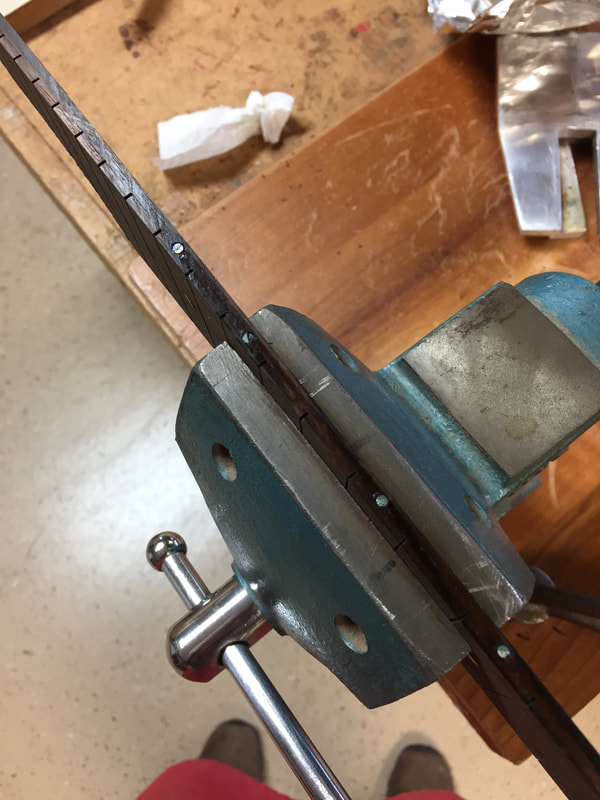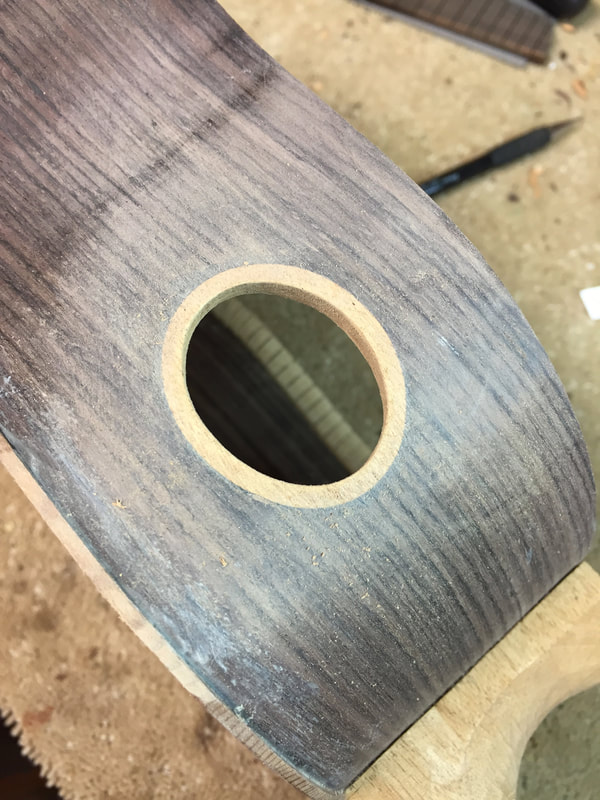It seemed appropriate to try some new things for the 100th instrument. So far it has been great fun and very interesting. The Kasha-Schneider design is a bit radical, very different both in bracing and exterior look. I am taking the opportunity to design and use a new peg head design, and a few other things.
Recovering from my mistake of yesterday that destroyed a fingerboard, I cut the slots in five more today. Once you get set up for it, you might as well do a few for the future.
These photos show the way the blank fingerboards are taped to the guide which links with the saw sled shown.
These photos show the way the blank fingerboards are taped to the guide which links with the saw sled shown.
Here you can see the little bronze pin that mates with the notch in the template that is taped to the fingerboard. Each pass through the special saw blade requires a one notch movement. Really quite simple and extremely accurate cuts result.
Once you get set up to cut fret slots, you might as well cut a few. I had just bought a few ebony fingerboards so it made sense to slot a few. Do you notice one of these is different?
It is this one, and it is destined for the Kasha-Schiener #100. I am going to use a "zero fret' on this ukulele, and carry the fret iron to the very end of the fingerboard just as a design feature.

This is the zero fret. a fret that the strings rest over, rather than resting over the nut. The nut will simply separate the strings, the height of the strings will be perfectly equal because they will start from this "zero fret". I had never heard of this techinique until seeing an instrument built by my friend Jon Dale, of Jupiter Ukuleles in Philadelphia. Then I saw Jay Lichties instruments at the Guild of American Luthiers convention recently. His had zero frets. What the heck, let's give it a try on #100.
This time I got it right. I took special care to first score the spot with an awl, then accent that spot with a tiny bit in a finger drill that would guide the 3/16 bit in the drill press into the hole. I got the wonderful Paua abalone dots into a straight line.
I confess to a fascination with this amazing shell. I am usually not much for bling, but this is my weakness.
I even put them on the fingerboard edge. I have decided this is the instrument to go wild on, #100.
Then it was time to put in the side sound port. Here is the interior view showing the ebony veneer backing patch put in to bolster the ukulele side. Also the Hondo mahogany soundport ring set in with super glue.
Here it is on the outside after a bit of sanding. I love sound ports.
So here is where we are at this point. The next step is to figure out a label to put on the back in this unusual sound hole place. Once that is done the back can be attached. Then I must find an appropriate wood to cover the peg head. I am thinking about a very dark piece of Cocobolo. This continues to be an interesting build.












